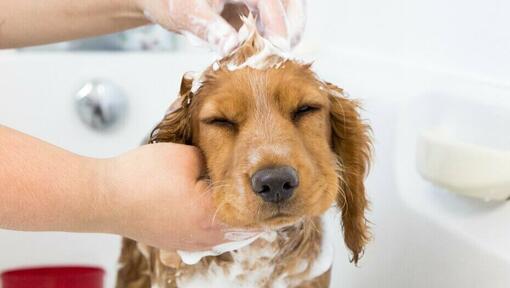Dog bathing is often viewed as a cosmetic routine—a way to keep your furry friend looking fresh and smelling pleasant. But beneath the lather and rinse lies a far more important function. Bathing isn’t just about cleanliness; it’s a foundational practice in supporting a dog’s comfort, hygiene, and long-term health.
For pet owners who seek to provide well-rounded care for their dogs, understanding the physical and psychological effects of regular bathing is essential. It’s not simply a matter of dirt removal but of reinforcing habits that promote overall wellness. When approached thoughtfully, dog bathing becomes an act of care that enhances the dog’s quality of life in ways far beyond appearances.
Skin Health and the Role of Regular Cleaning
The skin is a dog’s largest organ and the first line of defense against external irritants. It also reflects internal health. Maintaining healthy skin requires a clean environment, which is why routine bathing is critical. Dirt, bacteria, environmental allergens, and dead skin cells accumulate on the skin and coat over time.
Without proper cleaning, this buildup can lead to clogged pores, itchiness, and inflammation. For some dogs, it may progress to bacterial or fungal infections. Routine bathing helps prevent these conditions by clearing away irritants and maintaining the skin’s natural barrier.
Using the right type of shampoo for your dog’s skin—whether it’s moisturizing, hypoallergenic, or medicated—further protects against dryness or excessive oil production. Each bath becomes a chance to restore balance and support healthy regeneration of the skin.
Coat Maintenance and Shedding Control
A clean coat is not just soft to the touch—it functions properly. The coat acts as insulation, protects from sun exposure, and supports sensory input. Over time, oils, pollutants, and allergens can cling to a dog’s fur, reducing its ability to perform these tasks efficiently.
Regular dog bathing loosens and removes debris while supporting the natural shedding cycle. By bathing your dog and following it with thorough brushing, you help remove loose hairs before they fall throughout your home. This reduces matting, keeps skin beneath the fur healthier, and supports a cleaner living space for both pets and humans.
Seasonal shedders, in particular, benefit from regular baths. It’s during these periods that the coat is in a state of transition, and bathing accelerates the process in a comfortable and effective manner.
Allergy Relief for Dogs and Their Humans
Both dogs and their human companions can suffer from environmental allergies. Pollen, mold, and dust easily attach to a dog’s coat during walks or time outdoors. Without frequent bathing, those allergens are carried into the home, potentially triggering allergic reactions.
For dogs, allergens on the skin can lead to redness, hot spots, and intense itching. A dog may lick, scratch, or bite themselves to relieve discomfort, often worsening the irritation. Regular baths, using shampoos designed for sensitive or allergy-prone skin, wash away these allergens and reduce inflammation.
This preventative routine helps maintain comfort while avoiding the need for more intensive medical intervention later. It also benefits human household members who are sensitive to allergens.
Bathing as a Tool for Parasite Management
Fleas, ticks, and mites are not only uncomfortable but can lead to serious health concerns. While prevention through medication is essential, bathing plays a supporting role in parasite control.
Washing removes surface pests and helps detect signs of infestation early. It also makes the application of treatments more effective, ensuring that products can reach the skin instead of getting trapped in dirt or excess oils. Even after treatment, baths can soothe irritated skin and assist in the recovery process.
Dogs that regularly interact with other animals, visit outdoor parks, or attend dog daycare are particularly prone to exposure. Incorporating bathing into their health regimen reduces risk and supports faster identification of problems.
Observational Opportunities During Bath Time
Bathing gives pet owners a unique opportunity to observe their dog closely. As you lather and rinse, you may notice new lumps, changes in skin color, dry patches, or parasites you wouldn’t otherwise see. Early detection is one of the most powerful tools in preventing minor health concerns from becoming serious.
Dogs are masters at hiding discomfort. Routine bathing introduces moments of hands-on inspection that can reveal subtle health issues—whether physical or behavioral. The act of bathing becomes an extension of regular health monitoring.
Behavioral Benefits: Confidence and Comfort
The bathing process can positively influence a dog’s behavior and confidence. While not every dog enjoys water at first, regular exposure, paired with patience and gentle handling, can turn bath time into a bonding ritual.
Dogs that learn to associate bathing with calm and care are more likely to remain relaxed during other types of handling—like grooming, vet visits, and even nail trims. This desensitization builds emotional resilience and trust between the pet and owner.
For puppies, early introduction to dog bathing is especially beneficial. It lays the foundation for grooming as a normal part of life, rather than something to fear. As dogs grow, they carry that emotional security into adulthood.
The Right Bathing Schedule for Your Dog
There is no one-size-fits-all answer to how often a dog should be bathed. It depends on factors like breed, coat type, lifestyle, health conditions, and even the local climate. In general:
- Dogs with oily coats may benefit from more frequent bathing
- Dogs with dry skin should be bathed less often with moisturizing products
- Dogs that spend a lot of time outdoors may need baths more regularly
- Dogs attending dog daycare or dog boarding frequently may pick up more environmental debris
The key is balance. Overbathing can strip natural oils, while underbathing allows dirt and irritants to build up. A schedule informed by your dog’s unique needs—and guided by a veterinarian or grooming professional—ensures optimal results.
Choosing Products that Support Skin and Coat Health
Not all grooming products are created equally. Choosing a dog shampoo formulated with gentle, safe ingredients is critical. Avoid using human shampoos, which can disrupt the pH of a dog’s skin and cause irritation.
Look for ingredients that support moisture retention and skin balance, such as oatmeal, aloe vera, chamomile, or coconut oil. Fragrance-free or naturally scented options help prevent reactions in dogs with sensitivities.
Additionally, consider the use of conditioning sprays or rinses to detangle fur and add softness, especially for long-haired breeds. The right product pairing can make all the difference in skin comfort and coat appearance.
Professional vs. At-Home Bathing
Many dog owners bathe their pets at home, but there are times when professional grooming may be more effective or convenient. Large breeds, dogs with thick or matted coats, or those with special medical conditions often benefit from professional care.
Facilities like Karnik Pet Lodge at Maple Village offer a supportive environment where bathing is handled by individuals experienced in canine care. For dogs who are anxious or difficult to bathe at home, these facilities provide peace of mind. When combined with regular at-home grooming, professional baths help maintain hygiene and comfort year-round.
A Clean Dog is a Happy Dog
Dogs, by nature, are curious explorers. They sniff, roll, dig, and dash through their environment with enthusiasm. With that joy comes a certain amount of dirt—and that’s perfectly normal. But when that dirt is left unchecked, it can compromise their health, comfort, and behavior.
Bathing helps restore the physical balance between a dog’s natural desire to explore and their need to stay clean and healthy. It keeps skin soothed, coats manageable, and the bond between dog and owner strong.
Conclusion
Dog bathing is a simple yet powerful tool in promoting a pet’s overall wellness. It is not just a grooming ritual but a wellness practice rooted in observation, prevention, and emotional care. Clean fur and refreshed skin offer visible benefits, but the deeper impact lies in supporting physical comfort, behavioral confidence, and lifelong health.
Whether you bathe your dog at home or trust a facility like Karnik Pet Lodge at Maple Village, the goal remains the same: to keep your canine companion feeling their best. A clean dog is more than presentable—they’re happier, healthier, and more prepared to enjoy life at your side.






